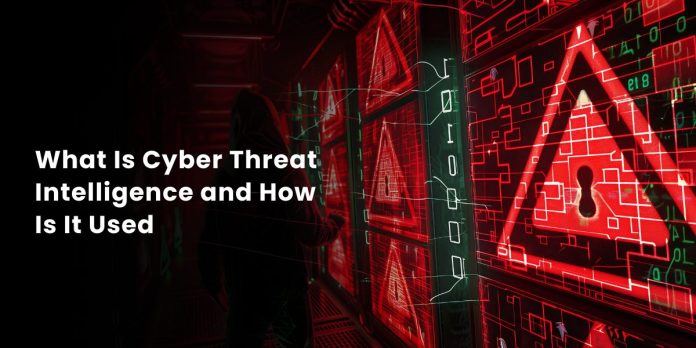Discover what Cyber Threat Intelligence (CTI) is and how it helps businesses proactively identify, mitigate, and respond to emerging cyber threats.
The digital world is evolving at an unprecedented pace, and so are the tactics of cybercriminals. Each day, organizations face new threats ranging from phishing attacks to sophisticated ransomware campaigns.
A 2023 report by the World Economic Forum highlighted that cybercrime is expected to cost the global economy $10.5 trillion annually by 2025, highlighting the need for strong cybersecurity strategies. This is where Cyber Threat Intelligence (CTI) becomes invaluable.
Unlike traditional reactive measures, CTI takes a proactive approach by gathering, analyzing, and interpreting data about current and potential cyber threats. It provides actionable insights that help businesses prevent breaches, mitigate risks, and respond effectively to incidents.
But what exactly is Cyber Threat Intelligence, and how does it work? In this article, we will explore the fundamentals of CTI, its practical applications, and why it’s becoming an essential part of modern cybersecurity frameworks. Whether you’re a cybersecurity professional, a business leader, or just someone interested in understanding how organizations protect themselves against cyber risks, this guide will provide clarity and actionable insights.
Table of Contents
What Is Cyber Threat Intelligence (CTI)?
Cyber Threat Intelligence (CTI) refers to the collection, analysis, and dissemination of information related to current and potential cyber threats. It focuses on understanding the motivations, tactics, techniques, and procedures (TTPs) of threat actors to enable proactive cybersecurity measures.
The ultimate goal of CTI is to provide actionable insights that help organizations prepare for, prevent, and respond to cyber threats effectively. This intelligence can be gathered from various sources, including threat intelligence platforms, open-source intelligence (OSINT), dark web monitoring, and third-party risk assessments.
The Importance of Threat Intelligence in Cybersecurity
- Proactive Defense: CTI helps organizations anticipate and prepare for potential threats, rather than reacting after an attack has occurred.
- Reduced Risks: Businesses can take targeted actions to minimize risk by identifying vulnerabilities and threat vectors.
- Informed Decision-Making: Threat intelligence equips cybersecurity teams with the information needed to prioritize and respond to the most critical threats.
- Enhanced Incident Response: With timely and actionable intelligence, organizations can respond faster and more effectively to security incidents.
- Supply Chain Risk Management: CTI provides visibility into risks posed by third parties, ensuring stronger supply chain security.
How to Use Cyber Threat Intelligence
Using Cyber Threat Intelligence effectively involves several steps:
- Collecting Relevant Data: Threat intelligence begins with data collection from various sources such as threat intelligence platforms, dark web monitoring tools, and vulnerability management solutions. This data can include information about phishing campaigns, malware strains, ransomware tactics, and more.
- Analyzing the Data: Collected data is analyzed to identify patterns, trends, and potential risks. Predictive threat intelligence solutions can provide insights into emerging threats by examining historical data and threat actor behaviors.
- Applying the Intelligence: The actionable insights derived from CTI can be used to:
- Strengthen security measures
- Develop targeted incident response plans
- Educate employees about potential threats
- Mitigate risks in third-party and supply chain ecosystems
- Continuous Monitoring and Updating: Threats evolve constantly, making continuous monitoring and updates essential. Businesses must regularly assess their threat landscape using CTI tools to stay ahead of attackers.
Benefits of Threat Intelligence for Businesses
The integration of cyber threat intelligence into cybersecurity frameworks offers several advantages:
- Improved Risk Management: CTI provides a clearer understanding of potential threats, enabling businesses to address them proactively.
- Better Resource Allocation: Intelligence-driven insights help prioritize security efforts and allocate resources effectively.
- Enhanced Compliance: Many industries require threat intelligence as part of their regulatory compliance measures.
- Supply Chain Security: By identifying vulnerabilities in third-party networks, CTI strengthens overall supply chain risk management.
- Predictive Analysis: Predictive threat intelligence solutions help forecast potential attacks, allowing businesses to prepare in advance.
- Cost Savings: Early detection of threats reduces the likelihood of expensive breaches and downtime.
Cyber Threat Intelligence Tools and Platforms
Organizations rely on various tools and platforms to gather, analyze, and act upon threat intelligence. Below are some key components of CTI tools:
- Threat Intelligence Platforms: These platforms consolidate data from multiple sources and provide actionable insights. They include features such as automated alerts, visual dashboards, and AI-driven analysis for effective threat management.
- Vulnerability Management Tools: These tools identify and prioritize vulnerabilities within an organization’s systems. By integrating CTI, vulnerability management solutions can determine which vulnerabilities are actively being targeted by attackers.
- Third-Party Risk Management Solutions: Supply chains and third-party vendors are often a weak link in cybersecurity. Threat intelligence tools assess the risks posed by external partners and suggest mitigation strategies.
- Dark Web Monitoring Tools: Dark web monitoring is critical for detecting stolen credentials, leaked sensitive data, and discussions about planned attacks. This intelligence can help prevent breaches before they occur.
- Predictive Threat Intelligence Solutions: These tools use advanced analytics and machine learning to forecast future attacks, enabling organizations to take preemptive measures.
- Brand Intelligence Tools: These tools protect against brand impersonation, phishing attacks, and fraudulent domains, ensuring a company’s reputation and customer trust remain intact.
Threat Intelligence Products Offered by Leading Companies
Numerous threat intelligence companies provide cutting-edge solutions tailored to meet diverse business needs. These products often combine multiple functionalities to provide comprehensive protection.
For instance, tools like Cyble Vision offer:
- Attack Surface Management: Identifies and mitigates risks across your organization’s external digital footprint.
- Cyber Threat Intelligence: Delivers real-time insights and AI-driven analysis to counter emerging threats.
- Dark Web Monitoring: Tracks dark web activities for potential leaks or threats.
- Vulnerability Management: Helps prioritize and address vulnerabilities effectively.
- Takedown Services: Removes fraudulent websites and disrupts malicious campaigns.
- Supply Chain Risk Management: Evaluates and mitigates risks associated with third-party collaborations.
Such tools enable businesses to adopt a proactive approach to cybersecurity while addressing both internal and external vulnerabilities.
Predictive Threat Intelligence Solutions: A Game-Changer
One of the most exciting advancements in CTI is predictive threat intelligence. These solutions leverage AI and machine learning to predict future threats based on historical attack patterns, TTPs of adversaries, and global threat trends.
Predictive intelligence can:
- Anticipate the methods likely to be used in upcoming attacks
- Provide advanced warning of risks to specific industries
- Offer tailored recommendations for mitigation
Businesses that incorporate predictive solutions into their cybersecurity strategy gain a significant edge in preventing cyberattacks.
How Businesses Can Choose the Right Threat Intelligence Tools
Selecting the right threat intelligence products and platforms depends on factors such as the organization’s size, industry, and specific security requirements. Here are some tips for making the right choice:
- Assess Your Needs: Identify the primary goals of your CTI program (e.g., supply chain security, vulnerability management).
- Look for Integration: Ensure the tool integrates with your existing security infrastructure, such as SIEM (Security Information and Event Management) or SOAR (Security Orchestration, Automation, and Response) systems.
- Prioritize Scalability: Choose tools that can scale as your organization grows.
- Evaluate Vendor Reputation: Work with trusted threat intelligence companies known for delivering reliable and effective solutions.
- Consider Predictive Capabilities: Predictive threat intelligence solutions are ideal for forward-looking organizations that want to stay ahead of attackers.
Conclusion
Cyber Threat Intelligence has become a cornerstone of modern cybersecurity, providing businesses with the insights needed to identify and mitigate risks before they materialize. By leveraging CTI tools, platforms, and solutions, organizations can enhance their security posture, protect critical assets, and build resilience against evolving threats.
The adoption of CTI is no longer optional—it is a necessity. Whether through threat intelligence platforms, dark web monitoring tools, or vulnerability management solutions, businesses must embrace these technologies to ensure vigorous security.
INTERESTING POSTS
- 7 Cyber Security Training Awareness Essentials For Employees
- AI Revolution: Protecting Your Cyber Future
- The Role of Artificial Intelligence in Cybersecurity
- The Transformative Impact of Artificial Intelligence on Surveillance and Safety
- Strengthening DDoS Protection with Threat Intelligence
About the Author:
Meet Angela Daniel, an esteemed cybersecurity expert and the Associate Editor at SecureBlitz. With a profound understanding of the digital security landscape, Angela is dedicated to sharing her wealth of knowledge with readers. Her insightful articles delve into the intricacies of cybersecurity, offering a beacon of understanding in the ever-evolving realm of online safety.
Angela's expertise is grounded in a passion for staying at the forefront of emerging threats and protective measures. Her commitment to empowering individuals and organizations with the tools and insights to safeguard their digital presence is unwavering.









